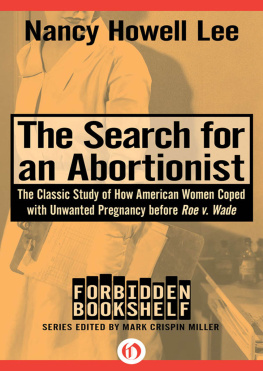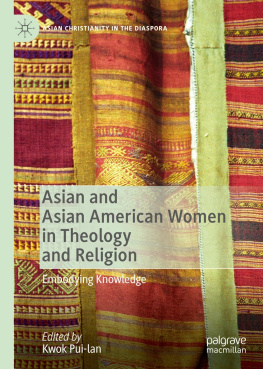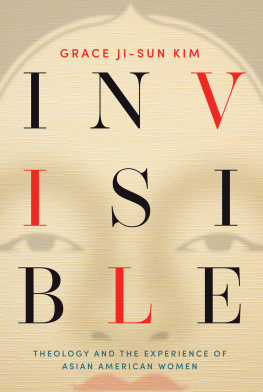
FROM A LIMINAL PLACE
FROM A
LIMINAL PLACE
AN ASIAN AMERICAN THEOLOGY
SANG HYUN LEE
Fortress Press
Minneapolis
FROM A LIMINAL PLACE
An Asian American Theology
Copyright 2010 Fortress Press, an imprint of Augsburg Fortress. All rights reserved. Except for brief quotations in critical articles or reviews, no part of this book may be reproduced in any manner without prior written permission from the publisher. Visit http://www.augsburgfortress.org/copyrights/contact.asp or write to Permissions, Augsburg Fortress, Box 1209, Minneapolis, MN 55440.
Scripture passages are from the New Revised Standard Version Bible copyright 1989 National Council of the Churches of Christ in the USA. Used by permission. All rights reserved.
Cover image: Handwritten Morning Sunscape by Delbert Michael (c. 1979)
Cover design: Laurie Ingram
Book design: PerfecType, Nashville, TN
Author photo: Kim Schmidt, Princeton Theological Seminary
eISBN 9781451418156
Library of Congress Cataloging-in-Publication Data
Lee, Sang Hyun, 1938-
From a liminal place : an Asian American theology / Sang Hyun Lee.
p. cm.
Includes bibliographical references and index.
ISBN 978-0-8006-9668-9 (alk. paper)
1. Asian AmericansReligious life. 2. Marginality, SocialReligious aspectsChristianity. I. Title.
BR563.A82L44 2010
230.08995dc22
2010013006
Dedicated to my family:
Inn Sook
Mi Hyong, Cy, Sandra,
Jacob, and Jordan
CONTENTS
When I was young, I used to think that one did theology in order to solve some difficult theoretical problem. I do theology in this book, however, not to deal with some theoretical issue but, rather, to find some meaning to my and my fellow Asian Americans lives in the United States. Is there any meaning or purpose in living ones entire life caught up between two worlds, belonging somewhat to both but, at the same time, not belonging wholly to eitherAsia or America? What theological meaning does a life have that is spent entirely at the periphery and not at the center of a society and culture?
In this book, I propose one possible Christian theological perspective on the above questions. In order to develop such a perspective, I must search the Scriptures. But everyone reads the Scriptures from a particular context whether he or she acknowledges it or not, and the context may affect his or her reading. So I begin this book by analyzing in Chapter 1 the context from which I search the Scriptures and do theology.
The Asian American experience has often been characterized as marginality. Marginality that is the result of marginalization is also said to have two aspects: the negative aspect of being excluded by the dominant group, and the positive aspect of being a potentially creative condition. For the purpose for clarity, I use the term marginality for the negative situation of being excluded, and refer to the potentially creative aspect of marginality with a different term, liminality. Liminality is the situation of being in between two or more worlds, and includes the meaning of being located at the periphery or edge of a society.
Liminality, according to the anthropologist Victor Turner, is a transitional time in which persons are freed from social-structure hierarchy and role playing and, therefore, may be more open to what is new, experience a close communion with other persons (communitas), and become capable of prophetic critique of the existing social order. The creative potentials of Asian Americans liminality, I argue, are in a frustrated and suppressed state because of the demoralizing and dehumanizing effects of marginalization.
When one approaches the biblical text from the perspective of a particular contextual background, certain matters stand out in ways that someone else with a different contextual background might not notice. Reading the Gospels with marginality and liminality in mind, I particularly noticed the fact that Jesus was a Jewish Galilean and that he conducted his public ministry primarily among Galileans. Then I also learned from historical studies that Galileans were very much a liminal and marginalized people.
Jesus Galilean identity leads us to other theological affirmations:
1. God became incarnate as a Galilean.
2. Jesus initial approach to Galileans in his ministry would seem to imply that it was strategic for God to do so because of Galileans liminality and their openness to what is new. Galileans were a people with sin just as any other people. But their social location of liminality made it likely that at least some of them would be open to the radically new message of Jesus (chap. 2).
3. If God in Jesus Christ assumed a liminal situation in time and history, and if what God does in history is not capricious but rooted in Gods own being, then we must posit liminality in God. Indeed, we can see the Fathers and the Sons experience of liminality in their mutual giving of themselves to the other. Jesus assumption of a liminal situation in time is a repetition or reiteration of the Fathers and Sons liminal experience within the Trinity (chap. 3). In this chapter I also outline the overall theological framework of the theology of the colonial American theologian Jonathan Edwards, which I believe can be the theological backbone of an Asian American theology.
Jesus was unlike other Galileans in that he was the incarnate Son of God, the second person of the Trinity. Unlike other Galileans, Jesus, in spite of the demoralizing effects of his marginalization, was able to exercise all of the three creative potentials of his liminality (openness to the new, communitas, prophetic knowledge and action) for the realization and personal embodiment of the reign of God. Chapter 4 traces the ways Jesus utilized his liminality to be open to God the Father, to build a new community, and to resist prophetically against the marginalizing forces of his day. As the new human being or a second Adam, Jesus embodied the way Asian Americans, and all other human beings, should live in their own liminal situation.
Chapter 5 concentrates on the climax of Jesus public ministry, the crucifixion, the resurrection, and the ascension. Jesus expression of the radical love of God that knows no boundaries, and his critique of the oppressive policies of the political and religious authorities led him to his death on the cross. As Jesus was dying on the cross, feeling abandoned even by his heavenly Father, he entered an infinite space of liminality out of which the infinite forgiving grace of God emerged in the form of the redeeming communitas. Those believers who with their own liminality join Jesus in this infinite liminality can experience the transforming communitas with God and enter into an everlasting communion with that God and a new life on earth.
Asian Americans experience of the redeeming communitas with God in Jesus is an experience of being accepted as Gods children in spite of their sinfulness, and also an experience of belonging to Gods family as equal members of that family with everyone else. The resurrection of the crucified Jesus confirms the truth and reality of Gods forgiving and accepting love.
Chapter 6 discusses the relationship between the Asian American Christians faith in the God of redeeming love and their identity as Asian Americans. Identity is thought of in a nonessentialist fashion as what happens through speech, action, and relationships. An Asian American identity, therefore, is constantly constructed and dissolved and then reconstructed. Identity emerges in a liminal space. Christian faiths primary function in this identity construction is to enable Asian Americans to face up to the task of constructing their identity in the bewildering space of liminality. The unity and
Next page















